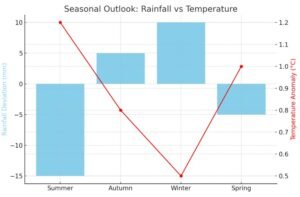As of July 1, 2025, BOM — short for Bureau of Meteorology — is the official weather, water, and climate authority of Australia. It operates under the Department of Climate Change, Energy, the Environment and Water and provides critical national services in environmental forecasting, public safety, and scientific research.
Founded in 1906 and formally established in 1908, BOM consolidated various state meteorology systems into a centralized federal agency. Today, it plays an essential role in helping Australians prepare for storms, floods, cyclones, and climate-related events.
BOM’s Core Services and Mission
The Bureau’s mission is to provide environmental intelligence for safety, sustainability, and prosperity. Its core offerings include:
- Weather Forecasts: From hyper-local 3-hour updates to weekly national outlooks
- Severe Weather Warnings: Cyclones, bushfires, flash floods, and heatwaves
- Radar & Satellite Data: Real-time maps showing rainfall and storm activity
- Marine & Coastal Forecasts: Surf, swell, tide, wind, and boating conditions
- Climate Research & Reporting: Seasonal outlooks, El Niño alerts, temperature anomalies
- Water Resources & Hydrology: Streamflow, drought monitoring, and flood modeling
- Scientific Research: Supporting agriculture, aviation, disaster management, and defense
Upgraded Radar Network for 2025
Between 2021–2024, BOM rolled out Australia’s largest-ever radar upgrade, significantly boosting regional weather visibility. Key radar advancements include:
- New Doppler Radars across NSW, QLD, VIC, NT, and WA
- Dual-polarisation radar technology for better storm and hail detection
- Radar loops now update as frequently as every 6 minutes, with improved resolution
- Enhanced radar coverage over rural and remote areas that were previously “blind spots”

This improvement directly benefits industries like agriculture, aviation, logistics, and emergency services — and improves public warning accuracy.
Understanding BOM Radar Maps
BOM’s radar maps show:
- Rainfall intensity (using color codes: green to red)
- Storm movement direction and loops
- Wind overlays and lightning strikes (on some radars)
- Zoom-in tools for regional tracking
These radars are refreshed in near-real-time, helping Australians plan daily activities, prepare for travel, or stay safe during extreme weather.
How BOM Alerts and Warnings Work
BOM issues emergency-level weather alerts across Australia — from cyclone watches in Darwin to flood warnings in New South Wales. Alert types include:
| Alert Level | Meaning |
|---|---|
| Advice | Developing conditions, stay informed |
| Watch | Increased risk, monitor closely |
| Warning | Immediate threat, take action now |
These alerts are distributed via the BOM website, official app, SMS, media outlets, and state-based emergency systems.
BOM Mobile App for 2025
The official BOM Weather App is available on Android and iOS and includes:
- Hourly and 7-day local weather
- Radar and satellite imagery
- Severe weather alerts (push notifications)
- Fire danger ratings, tide times, sunrise/sunset
- Favorite locations setup
Compared to third-party weather apps, BOM’s mobile app is government-backed, ad-free, and uses verified data, making it the most trustworthy option in Australia.
Climate & Environmental Monitoring
BOM is also Australia’s primary climate monitoring agency, responsible for tracking:
- El Niño/La Niña events
- Drought and rainfall deficits
- Sea surface temperatures and coral bleaching risk
- Heatwave frequency and severity
- Long-range seasonal outlooks
The agency’s climate modeling supports everything from water allocation to bushfire preparation, and contributes to global climate data used by scientists, NGOs, and governments.
Scientific Research and Innovation
BOM invests heavily in atmospheric, oceanographic, and hydrological science. Their research supports:
- Numerical weather prediction (NWP) using the ACCESS-S model
- Space weather forecasts affecting aviation and communication
- High-resolution storm modeling
- Climate projections for agriculture, marine biology, and urban planning
- Tools for reef forecasting, especially across the Great Barrier Reef

This science is applied in forecasting, climate change modeling, and hazard response planning — making BOM a global climate leader.
Water & Flood Management Services
BOM monitors and manages Australia’s critical water resources through:
- River and streamflow forecasting
- Flood alerts and warning systems
- Rainfall tracking and dam monitoring
- Urban water balance modeling
Their hydrological data supports city councils, farmers, emergency responders, and dam operators in managing flood risks and drought impact.
A Look Back: BOM’s Legacy and History
- 1906: Bureau created by the Meteorology Act
- 1908: First national forecasts published
- WWII: BOM meteorologists supported RAAF operations in the Pacific
- 1960s–1980s: Expanded use of satellites, radar, and computer modeling
- 2000s onward: Grew climate research and global collaboration
BOM has become a critical part of Australian infrastructure, combining technology, science, and public service in one institution.
Careers and Jobs at BOM
BOM employs more than 1,800 people across Australia in roles such as:
Core Job Roles
| Role | Function |
|---|---|
| Meteorologist | Forecasting, issuing warnings |
| Hydrologist | Water cycle analysis, flood modeling |
| Climate Analyst | Seasonal forecasting, data interpretation |
| IT Specialist | Radar system maintenance, cybersecurity |
| Data Scientist | Big data analysis for modeling & prediction |
| Communications Officer | Public information, education outreach |

Graduate Meteorologist Program
- 9–12 month training
- Open to science/STEM graduates
- Includes theory, practical simulations, and regional placement
BOM also supports Indigenous Australians, women in STEM, and those interested in working in Antarctica, climate policy, and space weather.
Volunteer Observers: The Unsung Heroes
Thousands of Australian citizens support BOM’s data collection by:
- Recording daily rainfall
- Reporting temperature, wind, and humidity
- Operating rural observation stations

Some volunteers have been active for 40+ years, contributing vital data that feeds into national climate modeling.
BOM vs. Other Weather Providers
| Feature | BOM | WeatherZone | AccuWeather | Windy |
|---|---|---|---|---|
| Government-backed | ✅ | ❌ | ❌ | ❌ |
| Real-time radar | ✅ | ✅ | ❌ | ✅ |
| Emergency alerts | ✅ | ❌ | ❌ | ❌ |
| Climate research included | ✅ | ❌ | ❌ | ❌ |
BOM is the only national agency with formal emergency responsibility, scientific authority, and policy relevance.
BOM Contact Info (Quick Guide)
| Department | Contact |
|---|---|
| General Enquiries | bom.gov.au |
| Support | support@bom.gov.au |
| Careers & Graduate Info | careers@bom.gov.au |
| National Phone | 1300 075 015 |
| Social Media | @BOM_au (X, Facebook, YouTube) |
FAQs
Q: Is BOM more accurate than other weather apps?
Yes — BOM uses the highest-resolution radar and expert meteorologists. Other apps often rely on global models with no human oversight.
Q: How often are BOM radar maps updated?
Every 6–10 minutes, with increased frequency during severe weather.
Q: Can I use BOM for marine or boating forecasts?
Yes — BOM has a dedicated section for marine, swell, tide, and wind forecasts tailored for sailors and beachgoers.
Q: Is BOM climate-neutral?
BOM is non-political and follows environmental science standards. It does not engage in political advocacy but supports evidence-based climate policy.
Q: How do I become a meteorologist at BOM?
You’ll need a science-based degree (e.g., physics, meteorology, mathematics), apply for the Graduate Meteorologist Program, and complete 9–12 months of training.
Final Takeaway
The Bureau of Meteorology is one of Australia’s most critical public agencies — delivering trusted, scientifically rigorous information that supports daily life, emergency response, and long-term climate resilience.
Whether you’re a commuter checking the forecast, a farmer planning crops, or a student exploring STEM careers — BOM’s tools, warnings, and data empower smarter, safer decisions.
Also read these article:

